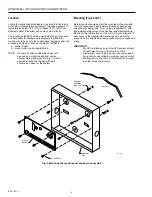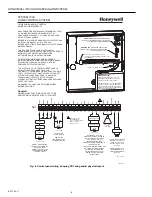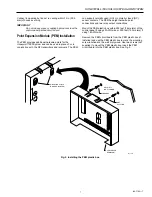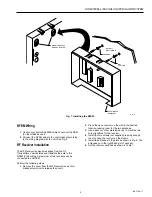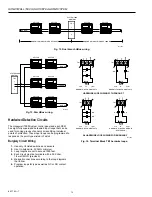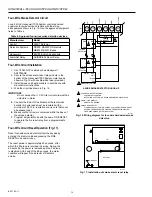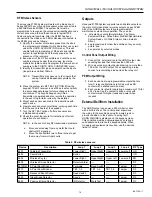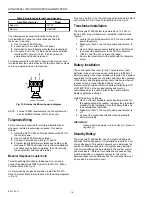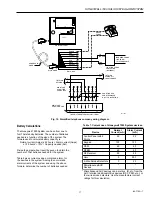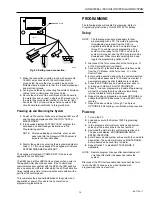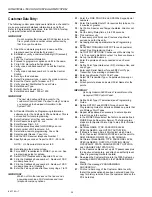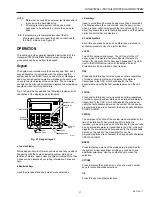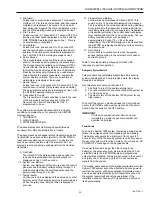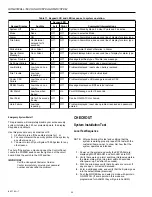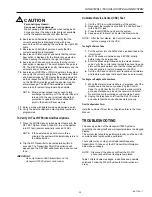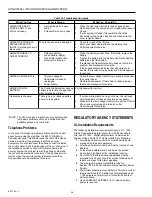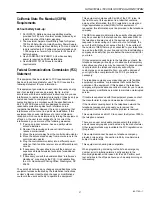
HONEYWELL 7000 SOLID STATE ALARM SYSTEM
69-1192—1
18
IMPORTANT
The following limits must not be exceeded:
1.
Maximum normal total current: 1.05A.
2.
Maximum alarm current on TB1-18 (HORN):
950 mA.
3.
Maximum alarm current on TB1-17 (AUX):
100 mA.
4.
Maximum number of batteries: 4 (28 AH total
capacity).
5.
Total current drawn from TB1-20 (+13.8 Vdc):
1.0A.
Minimum System
The minimum UL system is:
1.
One control panel.
2.
One keypad.
3.
Up to 10 two-wire smoke detectors (or equivalent four-
wire smoke detectors).
4.
One siren (950 mA model).
Table 8 summarizes the power calculations for this system.
Using the battery calculation formula:
(0.210A X 24 hours) + (1.185A X 1/15 hour) + 10% =
5.64 AH.
Device
Quantity
Normal Current
Each
Normal Current
Total
Alarm Current
Each
Alarm Current
Total
Control Panel with 8 Points
1
90
90
90
90
Keypad
1
120
120
120
120
PEM
0
60
0
60
0
RFEM
0
60
0
60
0
5881 RF Receiver
0
50
0
50
0
Horn
1
0
0
950
950
Smoke Detectors
10
0
0
25
25
Miscellaneous/AUX Devices
0
0
0
0
0
TOTALS
210
1185
This configuration requires one 7AH battery.
Maximum System
The maximum system is any configuration that requires 28AH
of standby battery power.
Sample Configurations
Table 9 lists sample configurations. Any of these
configurations can be downsized (less modules or
components) and still meet the battery standby times for that
configuration. Installation per these guidelines will meet the
California State Fire Marshal (CFSM) 24-hour battery backup
requirement.
Earth Wire Grounding
An earth ground can be a cold water pipe, a ground rod, the
metal framework of a building, or the reinforcing rod (concrete
rebar) of a building as shown in Fig 20. The third wire ground
in building electrical wiring should not be used as earth
ground as it is difficult to establish reliability as an earth
ground.
Configuration
No.
Standby
Battery
Hours
Number of
Batteries
Total
AH
RF
RFEM +
RCVR
PEM
Keypad
2-Wire Smoke
Detectors
(Maximum)
Aux.
Power
(mA)
Maximum
Normal
Current (mA)
Maximum
Alarm
Current (mA)
1
24
1
7
No
1
1
10
19
263
1455
2
24
1
8
No
0
2
10
27
301
1398
3
24
1
8
Yes
0
1
10
7
301
1405
4
24
2
14
No
1
4
10
13
527
1865
5
24
2
14
Yes
0
3
10
53
527
1870
6
24
2
14
Yes
2
2
10
23
527
1870
*7
4
1
7
Yes
4
5
None
10
900
2000
*8
4
1
7
Yes
0
7
None
10
840
2000
*9
4
1
7
No
0
8
None
0
810
2000
*10
4
1
7
No
4
6
None
0
870
2000
Table 8. Power calculations.
Table 9. Sample system configurations.
*These configurations are for non-fire applications.

